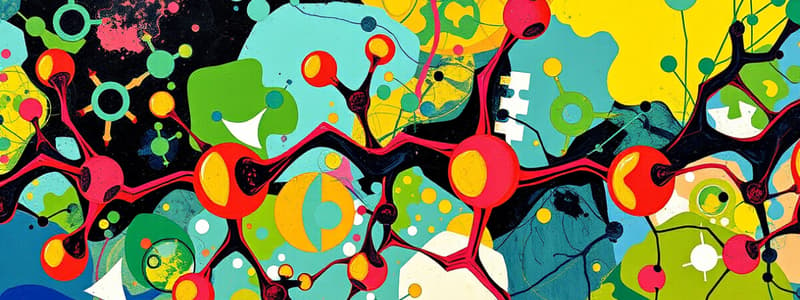Podcast
Questions and Answers
Which catecholamine is primarily synthesized in the adrenal medulla?
Which catecholamine is primarily synthesized in the adrenal medulla?
- Epinephrine (correct)
- Norepinephrine
- Dopamine
- Serotonin
Which function is NOT attributed to catecholamines?
Which function is NOT attributed to catecholamines?
- Acting as neurotransmitters
- Regulating heart rate
- Modulating blood pressure
- Building blocks for proteins (correct)
Which of the following is a methylated derivative of a neurotransmitter?
Which of the following is a methylated derivative of a neurotransmitter?
- Epinephrine (correct)
- Serotonin
- Acetylcholine
- Dopamine
Which catecholamine is primarily involved in the 'fight or flight' response?
Which catecholamine is primarily involved in the 'fight or flight' response?
What is the primary role of neurotransmitters like dopamine and norepinephrine in the brain?
What is the primary role of neurotransmitters like dopamine and norepinephrine in the brain?
What role does Monoamine Oxidase (MAO) play in the context of dopamine synthesis?
What role does Monoamine Oxidase (MAO) play in the context of dopamine synthesis?
Which factor is directly implicated in the development of movement disorders associated with Parkinson's Disease?
Which factor is directly implicated in the development of movement disorders associated with Parkinson's Disease?
Which of the following is a genetic component related to Parkinson's Disease?
Which of the following is a genetic component related to Parkinson's Disease?
What could be a cause of Parkinsonism as identified from the context provided?
What could be a cause of Parkinsonism as identified from the context provided?
What effect does decreased dopamine synthesis result in, particularly in relation to neurotransmitter balance?
What effect does decreased dopamine synthesis result in, particularly in relation to neurotransmitter balance?
What is the primary pathological characteristic associated with tremors and bradykinesia in the context given?
What is the primary pathological characteristic associated with tremors and bradykinesia in the context given?
Which type of neurons is NOT classified as dopaminergic according to the provided information?
Which type of neurons is NOT classified as dopaminergic according to the provided information?
What are Lewy bodies primarily composed of?
What are Lewy bodies primarily composed of?
What role does tyrosine hydroxylase play in dopamine synthesis?
What role does tyrosine hydroxylase play in dopamine synthesis?
During dopamine neurotransmitter activity, which process occurs last in the sequence?
During dopamine neurotransmitter activity, which process occurs last in the sequence?
What process leads to an increase in blood creatinine levels due to renal malfunction?
What process leads to an increase in blood creatinine levels due to renal malfunction?
Which amino acids are involved in the formation of glutathione?
Which amino acids are involved in the formation of glutathione?
What is the role of polyamines in relation to cell components?
What is the role of polyamines in relation to cell components?
Which of the following describes the structure of glutathione?
Which of the following describes the structure of glutathione?
What role does glutathione play as a sulfhydryl buffer?
What role does glutathione play as a sulfhydryl buffer?
Which statement about the excretion of creatinine in adults is accurate?
Which statement about the excretion of creatinine in adults is accurate?
What is the function of ornithine decarboxylase?
What is the function of ornithine decarboxylase?
What characteristic of the test reliability of a 24-hour urine sample is highlighted?
What characteristic of the test reliability of a 24-hour urine sample is highlighted?
Which enzyme is primarily responsible for the rate-limiting step in norepinephrine synthesis?
Which enzyme is primarily responsible for the rate-limiting step in norepinephrine synthesis?
Which factor acts as a negative effector in the regulation of tyrosine hydroxylase activity?
Which factor acts as a negative effector in the regulation of tyrosine hydroxylase activity?
What is the role of ascorbate in norepinephrine synthesis?
What is the role of ascorbate in norepinephrine synthesis?
Which of the following is a required substrate for phenylethanolamine N-methyltransferase?
Which of the following is a required substrate for phenylethanolamine N-methyltransferase?
Which compound is formed directly from DOPA by the action of DOPA decarboxylase?
Which compound is formed directly from DOPA by the action of DOPA decarboxylase?
What physiological response is associated with the increased levels of norepinephrine?
What physiological response is associated with the increased levels of norepinephrine?
Which cofactor is essential for the regeneration of tetrahydrobiopterin in the biosynthesis of norepinephrine?
Which cofactor is essential for the regeneration of tetrahydrobiopterin in the biosynthesis of norepinephrine?
In which location is phenylethanolamine N-methyltransferase primarily found?
In which location is phenylethanolamine N-methyltransferase primarily found?
What effect does epinephrine have on phenylethanolamine N-methyltransferase activity?
What effect does epinephrine have on phenylethanolamine N-methyltransferase activity?
Which amino acid serves as the precursor for several biologically important compounds including norepinephrine?
Which amino acid serves as the precursor for several biologically important compounds including norepinephrine?
Flashcards are hidden until you start studying
Study Notes
Overview of Catecholamines
- Catecholamines include dopamine, norepinephrine, and epinephrine, which are biologically active amines and neurotransmitters in the brain and autonomic nervous system.
- Key functions involve regulation of carbohydrate and lipid metabolism, stress responses, and increasing cardiac output and blood pressure.
Synthesis of Catecholamines
- Step 1: Tyrosine Hydroxylase catalyzes the conversion of tyrosine to L-DOPA, requiring tetrahydrobiopterin and NADPH; it is regulated by dopamine and norepinephrine.
- Step 2: DOPA Decarboxylase converts L-DOPA to dopamine, dependent on pyridoxal phosphate.
- Step 3: Dopamine Beta-Hydroxylase converts dopamine to norepinephrine, requires ascorbate and molecular oxygen.
- Step 4: Phenylethanolamine N-methyltransferase in the adrenal medulla converts norepinephrine to epinephrine; glucocorticoids induce this enzyme.
Degradation of Catecholamines
- Catecholamines are inactivated primarily by Monoamine Oxidase (MAO) through oxidative deamination.
- Catechol-O-methyltransferase (COMT) also participates in inactivating neurotransmitters via methylation.
- A key pathological characteristic of Parkinson's disease is the degeneration of the substantia nigra, leading to significant dopamine depletion.
Parkinson's Disease Details
- Symptoms arise when dopamine levels decrease by 80% in the nigrostriatal system, leading to movement disorders.
- Genetic factors and environmental exposures (e.g., viral infections, manganese levels in miners) are implicated in the onset of Parkinsonism.
- Diagnostic signs of Parkinson's include tremor and bradykinesia, and Leuy bodies are hallmarks of the condition.
Melanins
- Melanins are biological pigments produced in the eye, hair, and skin to protect against sunlight.
- Melanocytes are responsible for synthesizing melanin, which involves tyrosinase, a copper-dependent enzyme.
- Albinism results from a defect in tyrosinase.
Glutathione
- Glutathione is a tripeptide consisting of glutamate, cysteine, and glycine, existing in reduced (monomeric) and oxidized (dimeric) forms.
- Functions include acting as a sulfhydryl buffer, amino acid transport across cell membranes, and serving as a cofactor for certain enzymes.
Polyamines
- Polyamines are derived from ornithine and function as polycations at physiological pH, interacting with negatively charged cellular components.
- Ornithine Decarboxylase catalyzes the conversion of ornithine to putrescine; it is highly inducible and has a short half-life.
Studying That Suits You
Use AI to generate personalized quizzes and flashcards to suit your learning preferences.




